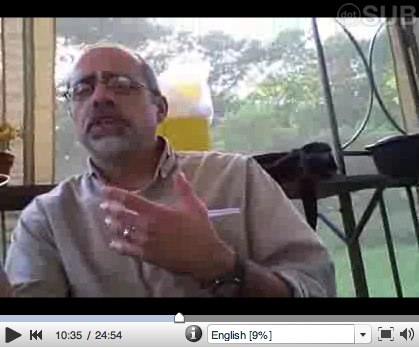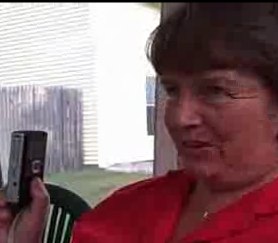 |
|
|
I’m finally watching Alice Barr (High School Technology Integrationist), Cheryl Oakes (K-12 Collaborative content coach), and Bob Sprankle’s (Wells School District Integrationis) keynote… “How Can I Become Part of this ReadWriteWeb Revolution?” (video) I was totally impressed with the opening, asking, “They’re teachers! How did they do that?” Then it occured to me. They were using Animoto. Excellent, I’m reminded of the very interesting act of making a commercial for learning.
Then I’m even more impressed with their technique. Basically, the three of them, all Maine’rs and distinguished (shall we say, “famous”) educators, are holding Flips up to each other and videoing each other as they talk. They’re having a conversation, and collecting it, three-way fashion, where, I assume, they edited it together afterward. This is so powerful, and so easy to do. I’m still mystified that in all the tech stores I visited in Hong Kong and Shanghai, I couldn’t find a single Flip.
 They talk about the 21st century Literacies, which now include media literacy, communication, Collaboration, innovation, information literacy, digital citizenship, ethics, civics, these are new information literacies. Of course, in a panel discussion I’ll be involved in at Friday’s TechForum in Palasaides, NY, David Jakes, our moderator, will be asking if there are, indeed, new literacies. What do you think?
They talk about the 21st century Literacies, which now include media literacy, communication, Collaboration, innovation, information literacy, digital citizenship, ethics, civics, these are new information literacies. Of course, in a panel discussion I’ll be involved in at Friday’s TechForum in Palasaides, NY, David Jakes, our moderator, will be asking if there are, indeed, new literacies. What do you think?
Alice also talks about creativity (my preference is inventiveness), invoking Thomas Friedman.
“So how do you do that, when you’re stuck in a classroom…?” Bob asks.
Their vision is, “Don’t do it alone!” Find a Cheers! They are actually doing the keynote in an out door cafe.
 I like Cheryl’s quest to make the classroom like an ongoing homecoming. On top of some many things that means, it attracts the involvement of the community — because the community has been there. We’ve all been there, in the classroom, and we remember — and we can be inspired to be a part of the “revolution,” as they call it.
I like Cheryl’s quest to make the classroom like an ongoing homecoming. On top of some many things that means, it attracts the involvement of the community — because the community has been there. We’ve all been there, in the classroom, and we remember — and we can be inspired to be a part of the “revolution,” as they call it.
Powered by ScribeFire.

There are no new literacies.
What do you mean, “There are no new literacies.” Don’t you know that this is the 21st century? Do you have any idea how long I’ve waited for the 21st century? How could it finally get here, and there not be “New literacies?” 😉
I certainly understand the tendency and even the need to talk about new literacies. But, at the risk of giving away my answer in tomorrow’s TechForum panel, I agree with you. There’s one literacy. The skills are changing/expanding, because the landscape is changing. But I agree that literacy isn’t changing, and that it serves us better, in education, to focus on literacy as one thing — the ability to use information to accomplish goals.
After dwelling on this MUCH more longer than I should have —
I am going to say “NO” as well. (Can I tell you, though, for 24 hours I have been on a pendulum about this. Made lists, wrote a blog post, wrote several comments here – deleted them all) and then came to MY FINAL conclusion of “NO”.
And look forward to the panel tomorrow morning to hear what I am sure will be quite an interesting discussion!!
Jen
David, what a thrill it was to find this in my morning reading! It was just like opening a present, with each layer I unwrapped my hopes were confirmed! You nailed each nugget that we embedded into our keynote. Prior to our “conversation”, Alice, Bob and I defined all the points we wanted to make, all the ideas we wanted to expose and most of all we wanted to deliver the passion we feel when we are demonstrating and sharing our craft. Thank you for explicitly pointing out each piece. Thanks for being a leader, a doer and a mentor.
Cheryl
I waited to hear your TechLearning keynote. I wondered what you would say about literacy. I was happy to hear your presentation. You always make me think and reflect. Literacy is literacy. Reading numbers now is numeracy. Since before people wrote or read, humans have always tried to make meaning of their surroundings. Through pictures on walls, writing on walls, to images and the written word we are constantly making meaning of our surroundings. The only thing I think that we need to share with educators is that we need to reflect and make meaning about all modes of communication and information. Not only do we need to understand these modes, we need to share with our students how to produce using these modes. Thanks for the “new” ways of thinking about communication.Cheryl